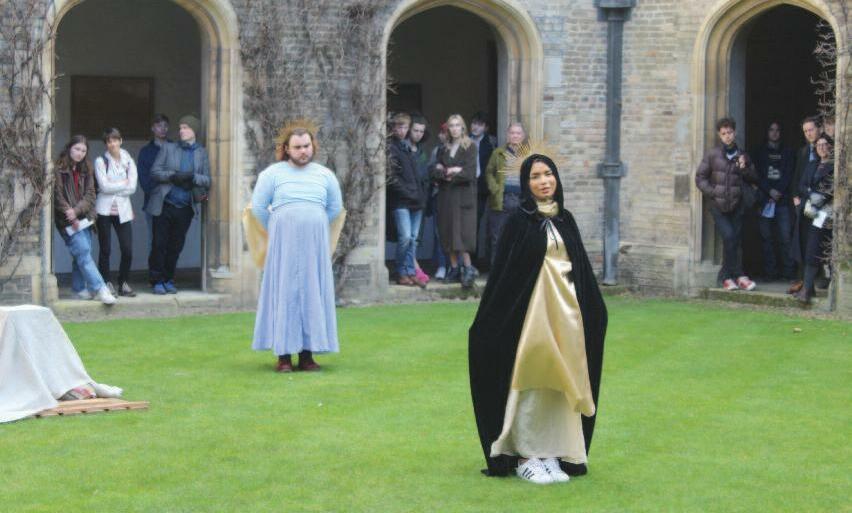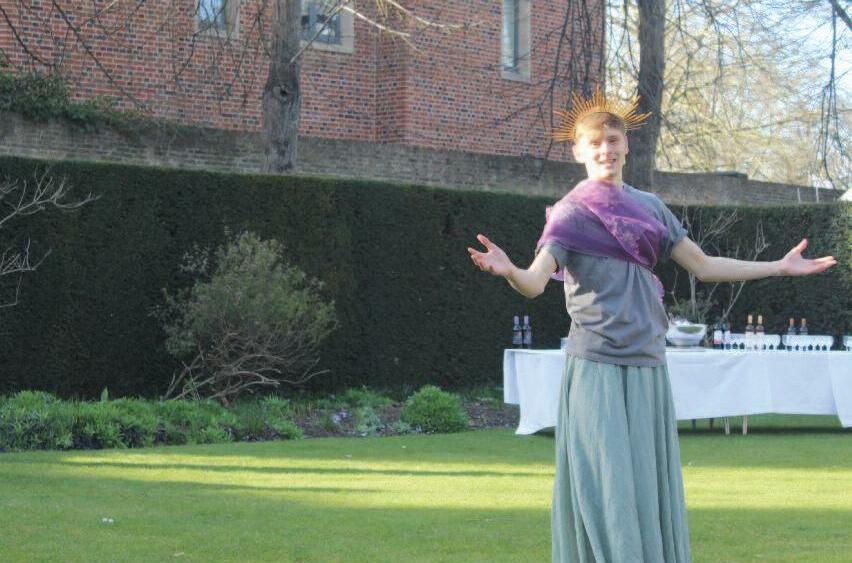
5 minute read
Resurrecting a tradition: ‘A Type of Christ’ Anika Goddard
Resurrecting a tradition: ‘A Type of Christ’
Undergraduate student in English, Anika Goddard (2021), writes about the challenges she faced directing the Jesus College Mystery Play this year
Advertisement
Directing the Jesus College Mystery Play came with the peculiar terror of 700 years (give or take) of performance history. Most of the plays we eventually settled on had been part of the fabric of English theatrical tradition hundreds of years longer than Shakespeare and would have had a significant impact on how their medieval audiences experienced faith. We knew, too, that we were reviving an old College tradition, and had the gorgeous costume designs and effective set design of the 1956 production of Felix Culpa to live up to, so no pressure at all, really!
Costume designers Megan and Lily noted that, “We tried to pay homage to the designs for the last Jesus College Mystery Play as well as incorporating our own ideas. It was so much fun looking at medieval paintings for inspiration. ” Having such a rich history to draw on also helped us as Directors to put our all into organising the plays, both creatively and logistically. Co-directing as a team of three not only helped with the workload, but ensured that all three of us brought different, but cohesive passions to the table. Niamh Bradshaw had picked up on the fascinating prevalence of women in the plays of the Chester cycle, particularly in times of mourning, and wanted to amplify those voices further. Nathan Brooks was interested in the way in which the York Crucifixion is framed as four men at work – until they raise the cross and you realise that they ’ re casually crucifying Jesus – and spliced it into the other Chester plays. I focused on the divine motif of God gradually coming closer to the audience throughout the cycle, beginning as a disembodied voice for Noah’s Deluge and ending as Jesus directly serving the audience drinks after The Resurrection.
We had always planned to perform the

Jesus (Angus Harron) and the Ensemble in The Crucifixion
play as a promenade – that is, moving around the College as mystery plays traditionally move around the city that they are performed in. The generosity of the Jesus College grounds staff enabled us to construct a logistical chiasmus, where prevalent themes were linked to location (a bonus being that we were able to showcase four separate locations of our lovely College to the audience).
Noah’s Deluge, our first play (directed by Nathan) began in the Orchard, with the Roost bar functioning as an ark. We also offered local schoolchildren the opportunity to take part in a free ‘Art in the Ark’ workshop beforehand and then act as animals processing into the ark for the real thing. This workshop, led by Francesca White, was a remarkable success and we hope that next year we ’ll be able to expand it by working with the Red Hen charity. After Noah, the audience was drawn by drum across First Court and into Cloister Court, which works well as a natural theatre, for Abraham and Isaac (directed by me). Though this was tonally one of the darkest plays, the sacrifice of Isaac was saved at the last minute by the appearance of an enormous stuffed sheep to act as a stand-in. A type of Christ, indeed.
Then we were into our beautiful College Chapel for The Nativity and The Adoration of the Magi/Slaying of the Innocents (all directed by Niamh Bradshaw), where pieces sung by the choristers, soloist Ella Curry and the entirety of the female cast brought the themes of mourning and female fellowship to life. Music Director Imogen Aley, who composed the melody for the lullaby A Baby ys Born us Blysse to Bring, said, “Seeing actors gain confidence with their singing and interpret my music to fit with their characters was a deeply rewarding experience ” . Another highlight of this section of the play was a demonically camp and fabulously dressed King Herod, who was taken down to hell, Faustus-like, by a devil as punishment for his villainy.
Following our chiasmus back out from its centre, we returned to Cloister Court for another sacrifice of a son in The Crucifixion (directed by Nathan).
The real spectacle was a cross three metres tall and loaned from professional Roman reenactors at The Passion Trust. “Both the biggest thrill and the biggest challenge of pulling it off was the cross ” , says Nathan, and it was certainly a precarious task to raise and lower it with the eyes of one hundred and fifty audience members on us, “but the struggle played right into the script’ s focus on the manual labour behind the crucifixion ” .
After the choristers had sung Elgar ’ s Ave Verum, the audience headed to the Fellows ’ Garden for the sixth and final play, The Resurrection (directed by me). Biblically, Jesus ’ resurrection was supposed to have taken place in a garden, and fortunately for us the sunny day made the flowerbeds in particular look appropriately seasonal. A drinks reception afterwards, in which costumed cast and audience ate together, brought back our central theme of fellowship one final time in an echo of the Last Supper.
A particular challenge was in how to frame the play: ‘ mystery play ’ initially left people expecting a medieval Agatha Christie, and we were careful to emphasise that our interpretation was faithful in the sense of loyalty to tradition rather than religion. Rachel Gardner ’ s striking posters, and regular Instagram updates by our publicity team helped to overcome these misconceptions and fill every one of our one hundred and fifty available places. I think I can speak for all three of us Directors in saying that this has been an exhausting, but fantastically rewarding, experience. We were lucky to have the financial support of the Judith E Wilson Fund, enabling us to re-establish a College tradition that we hope will continue to develop next year. As with all drama, our careful preparations would have been for nothing if our wonderful cast hadn ’t shown up on the day and given it their all. Thanks to the collective efforts of around thirty talented Jesuans, as well as some students from other colleges, we were able to bring A Type of Christ to life.
Niamh summarises the value of collaboration well in a piece of advice to next year ’ s directors: “Co-ordination is key… there are so many parts which make up the whole. The most important thing to remember? Use your voice ” . n











